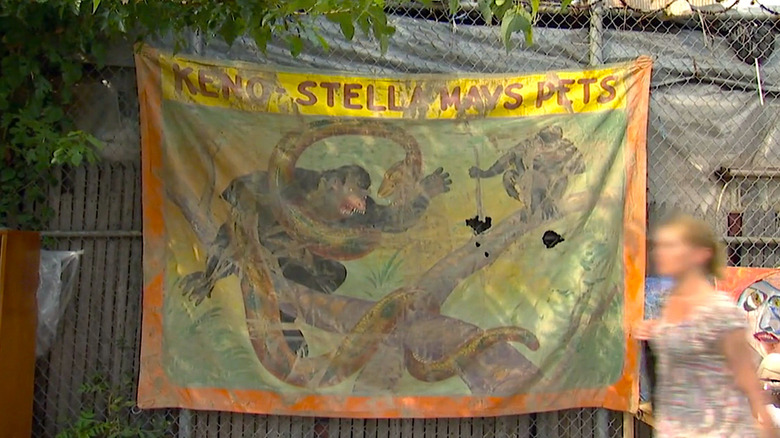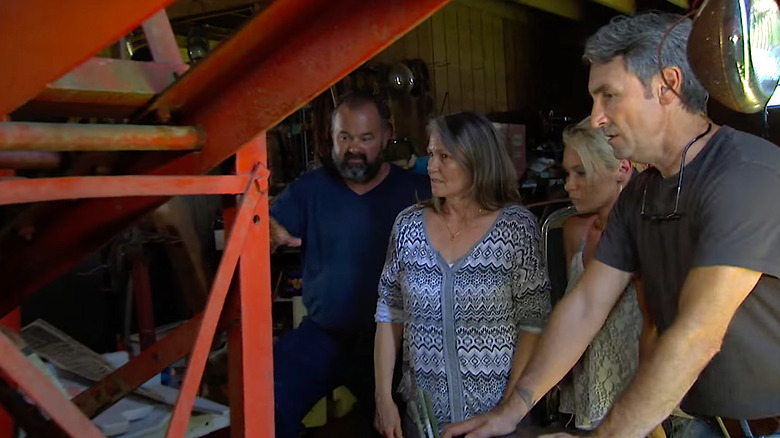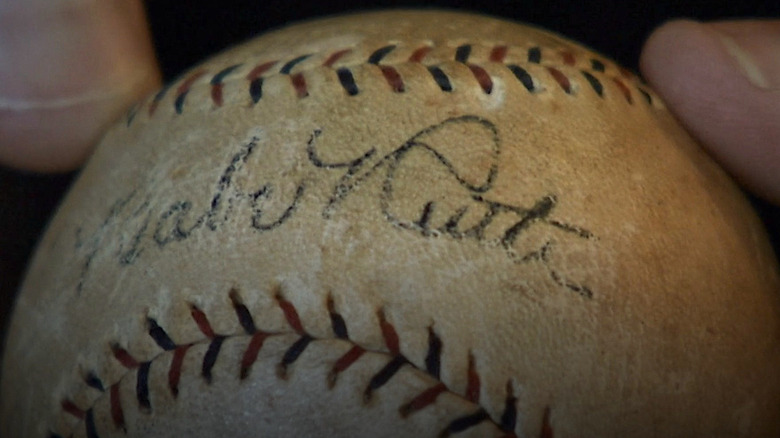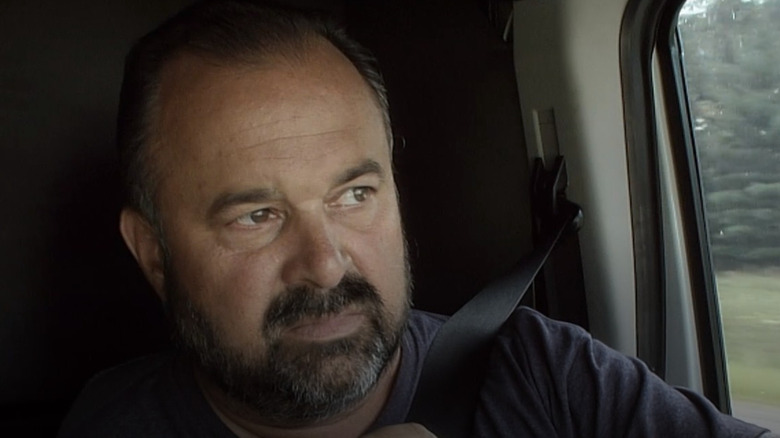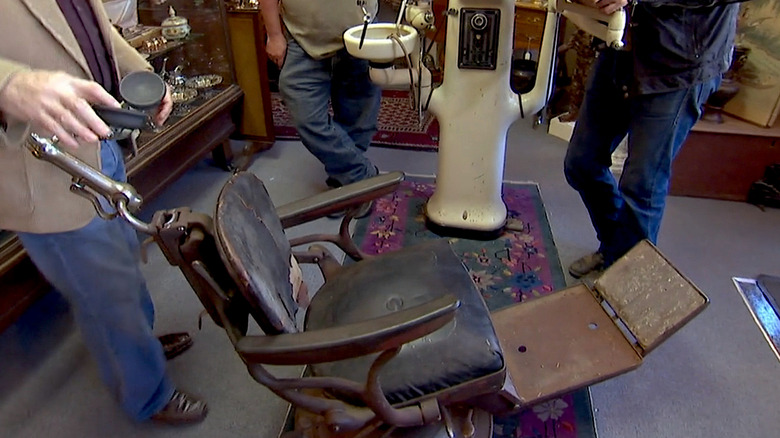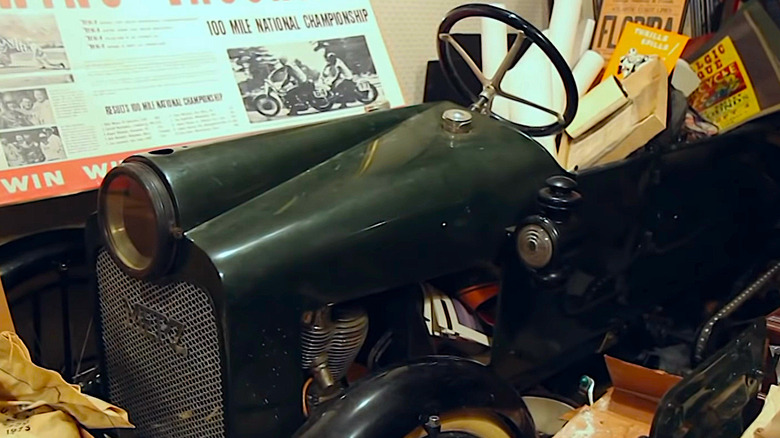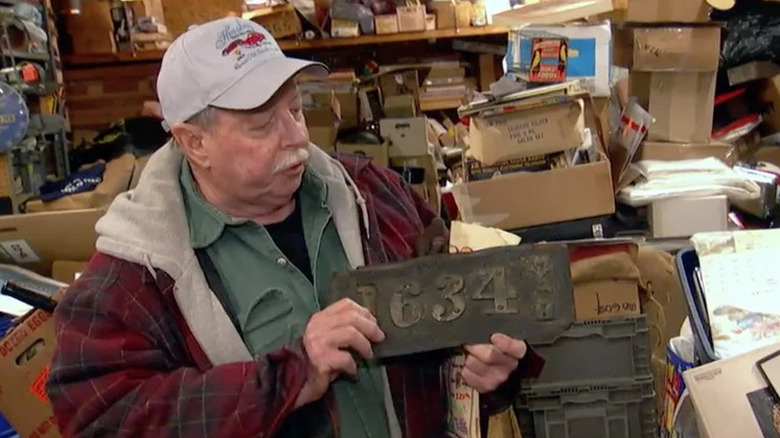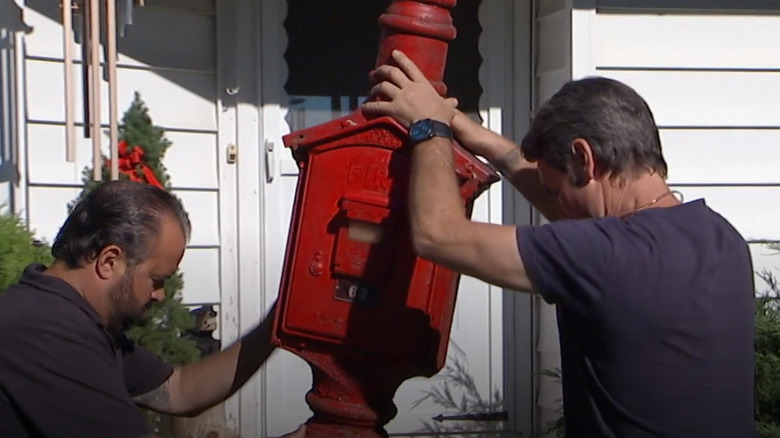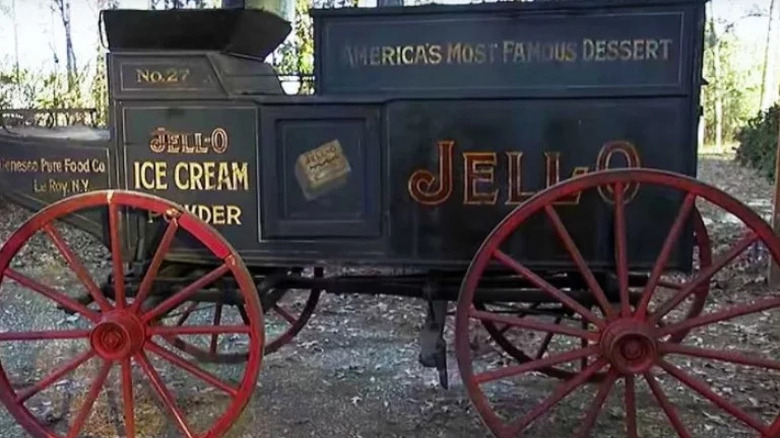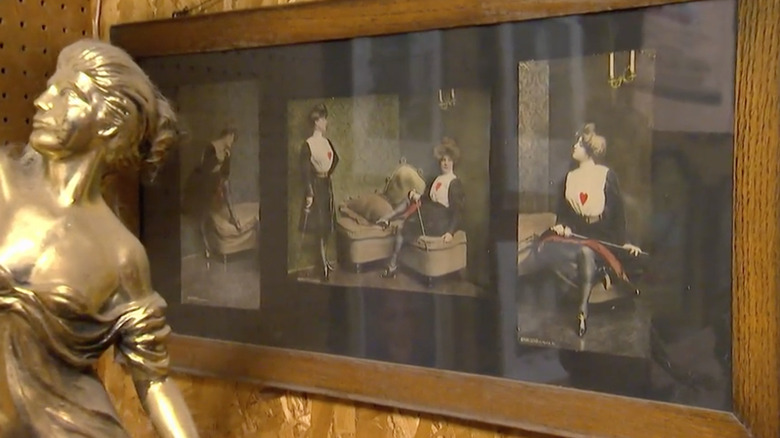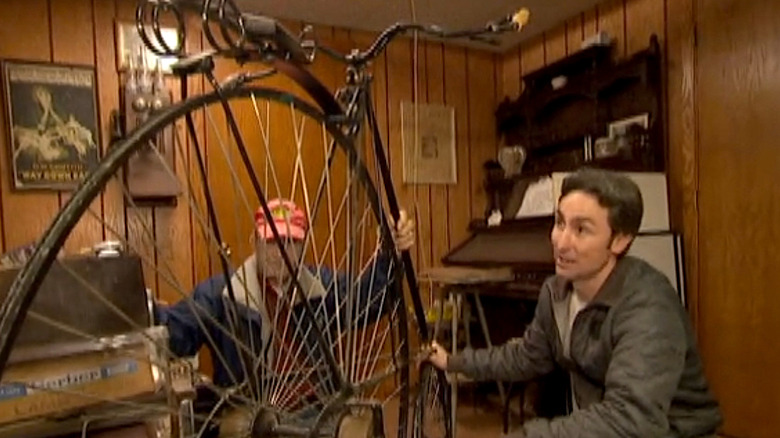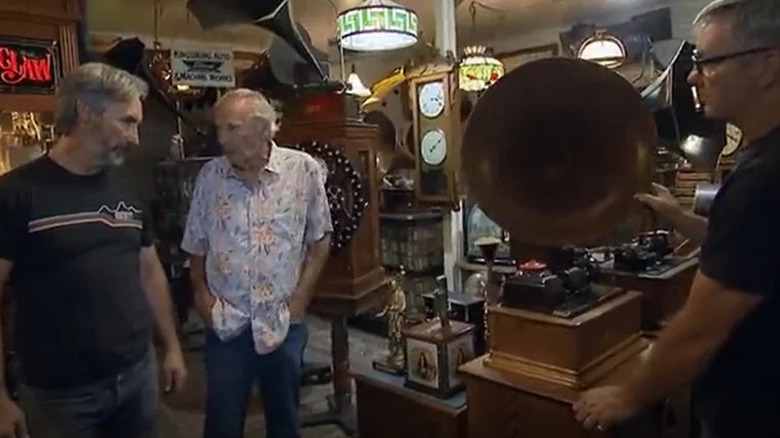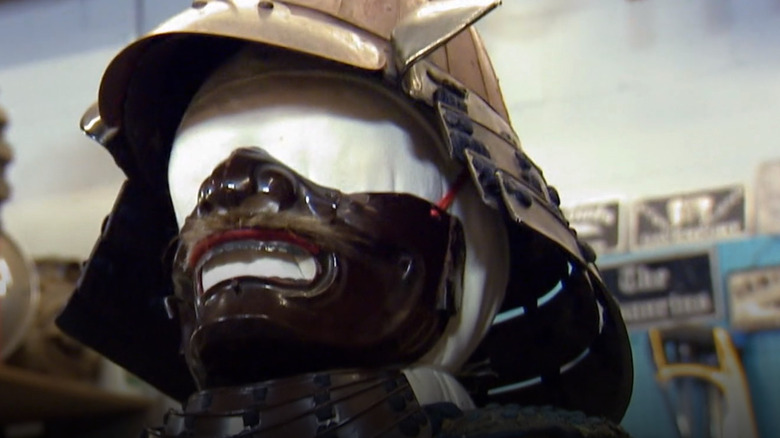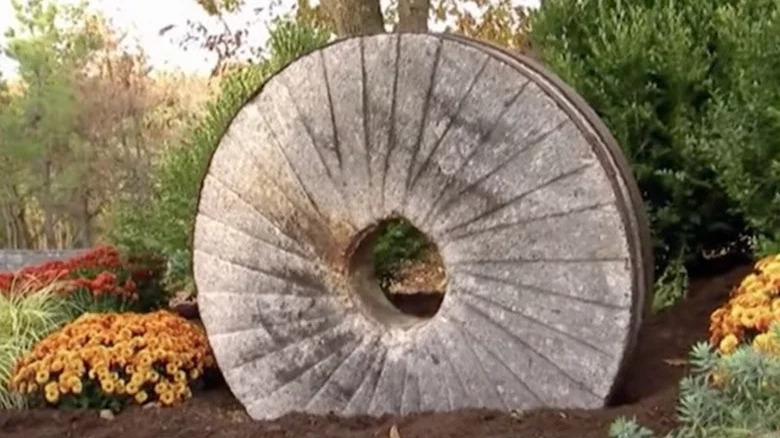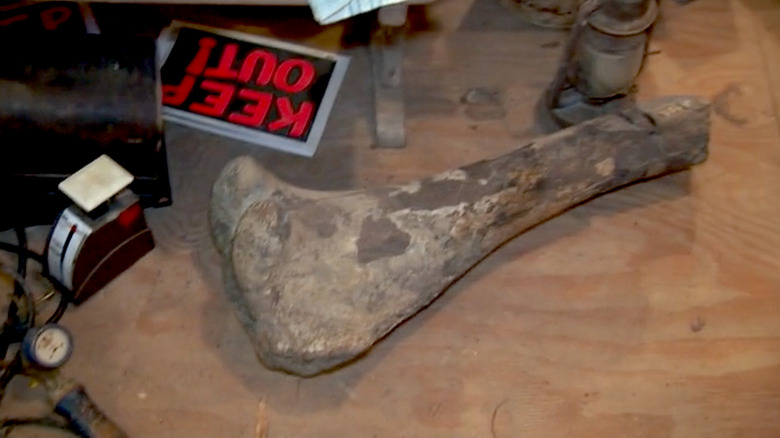15 Oldest Items That The American Pickers Have Picked
"American Pickers" is a show that knows the value of age. Finding antiques in strange hidey-holes is how pickers earn their daily bread. Plus, the show has been running since January 2010 on The History Channel. "Old" is an American Picker's business.
Yes, the show has had its ups, downs, and internal feuds. Of course, the most expensive picks are also interesting to explore. But we want to know, in all the outbuildings in all the country, what's the oldest stuff the pickers have encountered? What is the crustiest, rustiest gold?
This Looper historian has searched for the oldest possible finds in the entire "American Pickers" digital catalog. Beauty is in the eye of the beholder, value is in the eye of the appraiser, but in the eyes of a picker, old things are king. We hope you enjoy these 15 oldest items that the pickers of "American Pickers" have picked (say that three times fast), ordered by approximate age.
1. Sideshow banners
There are older picks than the 1940s sideshow banners from "American Pickers" Season 3, Episode 1, but since they come from an amusement park that first opened in 1902 and they inspired the show's most heartwarming scene, the kids stay in the picture.
Mike and Frank hit up Bushkill Park, a Pennsylvania amusement park plagued by flood damage and bad luck. Closed for years and still not operational during the pickers' visit, owner Neal was open to selling some items in order to help cover reopening costs. Mike and Frank scored some smalls, but then hit pay dirt in the form of intense (and intensely damaged) sideshow banners.
While the boys thought they were blown away by the banners' content — a gorilla battling an anaconda will do that — they're soon even more amazed when their NYC-based appraiser lets them know the banners were painted by Fred Johnson in the 1940s and are worth $5,000 apiece. Mike and Frank split the profits with the amusement park, hoping to aid in the renovation of a forgotten funhouse of America's history.
2. A rare Ford tow truck
In "American Pickers" Season 18, Episode 8, Mike and Frank hit upon "the mother lode": a 1929 Ford Model AA tow truck being sold by Vanessa and Savannah, a mother-daughter duo who run their family's Model A shop in Indiana. Model As run in the family's blood. Vanessa's father, Bill, was known as the "Model A King," but Vanessa just may be their new queen.
Vanessa, Mike, and Frank talk serious shop and make deals throughout the pick, but Mike's eyes light up the second he sees the "Double A," especially because the rare truck comes with all of its parts.
Before tow trucks were invented, literal horsepower was the only option to get a vehicle out of a jam. When the Model AA arrived, drivers finally had something stronger to tow their Model T's. Of course, Vanessa's boyfriend Brad tows the Ford truck out of the barn using a Chevy Silverado.
3. A genuine piece of baseball history
Baseball greats Babe Ruth and Lou Gehrig helped the underdog Yankees win the 1928 World Series. Generations of signature forgers have tried to make money off of fake team signature balls from the fateful game. In Season 19, Episode 18, "Pickin' for the Fences," the "American Pickers" boys encounter a Yankees 1928 series ball — or so they think.
The ball is in bad shape. While Babe Ruth's signature is clear as a bell, Lou Gehrig's signature is barely there, if it's really there at all. The other panels of the ball are scrawled with some recognizable names, but there's no way for Mike Wolfe or Frank Fritz to be certain about the authenticity. Still, the not-so-savvy-with-sports fans make the deal for $3,000, hoping to profit by selling it for $5,000.
Danielle gets the ball looked at in Season 19, Episode 23, "Pickers Like It Hot" by PSA's Kevin Keating. The autograph authenticator confirms the ball is genuine, and that it indeed is signed by Lou Gehrig as well as Babe Ruth. If the ball were in mint condition, he assures Danielle the value would sit somewhere between $25,000 to $50,000. However, its actual condition puts the value at $5,000. Danielle shares this "win" with the boys and lets them have their home run moment. Why spoil the game of picking with what could've been?
4. An intense peanut roaster
Everyone knows dreams are priceless, but what about nightmares? The "American Pickers" paid $13,000 for a 1920s Mr. Peanut roaster. It's a lot to shell out for one of the Pickers' oldest picks — and the new face that will haunt you the rest of your days.
Frank Fritz sets his sights on the nutty device in Season 16, Episode 1, "Tough Nut to Crack." The Peanut Roaster (or "Rider," to those hip to the nut-roasting biz) was instated in Planters Peanut Shoppes around America to freshly roast nuts for the pre–nut-allergy masses. Mr. Peanut memorabilia is very collectible, and one of these roasters already rests in The Smithsonian.
The Springfield, Missouri, man Frank negotiates with drives a hard bargain, but Frank drives even harder. Frank talks the roaster's asking price down from $16,000, saving at least a couple of peanuts before taking this Mr. Peanut to market.
5. Little dentist chair of horrors
Finding a rusty dentist chair that looks like a medieval torture device after being chased around a barn by a rogue emu is just another day in the life of an American Picker. The boys find this 1920s dental delight in Season 3, Episode 7, and Mike immediately imagines its perfect buyer: Lady Gaga.
While Mother Monster may pass on the creepy dentist chair option, this 1920s Ritter-manufactured model is impressive. It's fully equipped with gauges, tools, and a porcelain spittoon. However horror-movie-ready this model may look, the chair is actually a huge improvement on earlier versions.
According to the University of the Pacific's Virtual Dental Museum, 16th-century toothache patients would have begged for the comforts of the creepy chair. Instead, patients had their heads stabilized for tooth pulling in a much scarier spot: in the vice grip of their dentist's knees. Even though the Ritter model is appraised to sell for $1,000, we must say the "new" technology is priceless.
6. An ultra-rare hybrid car
Mike Wolfe has a great love of vintage cars and motorcycles, so it's fitting that one of the oldest (and most expensive) "American Pickers" picks combines the two. The Merz Cycle car is a 1914 feat of engineering and imagination introduced before automobiles totally ruled the road.
According to the National Motorcycle Museum, the Merz cycle car paired a light automobile frame with large displacement motorcycle engines. Two people could ride side by side in the car, which was popular in the US and England, even though it was only slightly less expensive than a Model T.
Charley Merz, famous for being an Indianapolis racing great who drove in the first three Indy 500s, built the cars with Merz Engineering. Only two remain today: one sold to the pickers by Pat in Florida, and the other in the National Motorcycle Museum. Considering the vehicle's rarity, place in transportation history, and great condition, the sticker shock of the $35,000 it cost the Pickers is almost in the rearview.
7. A leather license plate
It costs a fortune to make sure your car's stickers are up to date and your license is renewed, but at least your plates didn't set you back a cool grand. The "American Pickers" handed over a thousand dollars to pick an ultimate piece of "Automotive Archaeology" on Season 4, Episode 10: a leather Oldsmobile license plate from 1908.
License plates only started to be required for cars in the very early 1900s. Materials and location of the plates weren't standardized for some time after, and according to LeatherLicensePlates.com, leather and metal were the most durable options in the early days. According to Autoweek, the license plate picked by the Pickers comes with a clear provenance: an Olds factory in Lansing, MI.
The Pickers like to tell the history of America "one piece at a time," and they sold this particular piece of automotive history to the Lansing R.E. Olds Transportation Museum.
8. The haunted honeyhole haul
You know that an episode titled "Haunted Honeyhole" suggests "American Pickers" are picking up some serious rusty gold — and maybe a couple of rusty ghosts. Season 8's third episode features a building stuffed to the brim with old picks and spooky sounds. As Mike shouts, "Ghosts or no ghosts, we got a lot of picking to do!"
The boys pick up an antique honeyhole hat trick: a 1904 cast iron fire alarm call box, a 1920s blasting machine, and a 1920s movie lobby stand. Understandably, Mike hoots and hollers about all three.
He calls the dynamite blasting machine a "mantique," and snatches it up to sell to a fan of destruction and/or Wile E Coyote. He admires the movie lobby stand for its original lining. Both he and the specialist Danielle calls in get hot for the cast iron fire alarm call box. Invented in Boston, the system is still in use there, and some of the call boxes are over a century old.
9. A horse-drawn Jell-O wagon
When you were a kid, the calliope music of a passing ice cream truck set you running. Back in the early 1900s, your ancestors might've pedaled their velocipedes in hot pursuit of the cool relief offered by the creaky, squeaky Jell-O wagon. The "American Pickers" snagged a 1904 horse-drawn Jell-O wagon from a Louisiana barn in Season 17, Episode 4.
The wagon still has its original dark green paint and hand-painted gold-leaf lettering advertising "America's Most Famous Dessert." Buffalo Transportation Pierce-Arrow Museum owner Jim Sandoro acquired the wagon from the pickers and brought the vehicle back to its East Coast powdered ice cream roots. He tells Buffalo Rising, "It was made by George Higgins of Rochester, NY, for the Jell-O company of Leroy, NY. The wagon is a significant symbol of turn of the century advertising."
Danielle even made an appearance at the wagon's debut at the Pierce-Arrow museum. We can only hope some sort of Jell-O was served.
10. Progressive-era erotica
One of the best finds on "American Pickers" is also one of the oldest and most misunderstood. In Season 2, Episode 9, the boys stumble into a moving sale and soon discover a treasure trove of what appear to be racy antique photographs of women fencing — at least, at first blush.
The faded photos star a group of women with Gibson girl hairstyles, mid-length skirts, and high-necked blouses marked with vibrant red heart appliqués on the chest. Each woman brandishes a blade and a smile. It makes sense that the guys think they're looking at vintage erotica, but the images may actually be an example of Progressive-era cosplay.
According to The Historical Fencer, the costumes the women wear in the photos are inspired by the popular early 1900s painting "The Fencing Girl" by Jean Béraud. The painting sparked a craze, and lead to copycat photos and costumes sweeping Paris and the US. Broadway producer Florenz Ziegfeld (of "Ziegfeld Follies" fame) even reproduced the costume for his chorus girls. It's only a matter of time before someone decides to wear the costume again, maybe this time to Comic Con.
11. The most hipster bike of all time
Bikes have always been rusty gold-digger Mike Wolfe's ride-or-dies, so it's fitting that an incredibly rare bike is one of the oldest "American Pickers" picks. The Star High-Wheel Safety Bike, picked in Season 1, Episode 12, is almost as old as the hills turn-of-the-century riders could (almost) safely ride it down.
Sometimes called a "penny-farthing," you may recognize this bike with one comically large wheel (the penny) and one small wheel (the farthing) from Charlie Chaplin movies or your local hipster hangout. Old models used the large wheel to steer, and old-timey street obstacles (rats, urchins, small stones) often lead to riders flipping over the bars and crashing to the ground from a great height, AKA "taking a header."
The "safety" high-wheeler first rode onto the scene in 1880. The model, patented by George Pressey, moved the small wheel to the front for better steering and stability. Mike's amazement that the bike survived the scrap drives of World War II speaks to how rare the bike is and how much he loves bikes.
12. Thomas Edison's phonograph
Thomas Edison: inventor of the light bulb, the movie projector, and one of "American Pickers" oldest picks, the phonograph. He created this machine, which could record and play music, in 1877 (via America's Story). Edison deemed it his "favorite invention," and maybe it's yours, too; after all, it did revolutionize recorded music from its very inception.
While Edison probably knew he was onto something with the whole "inventing what will one day be easily accessed by Spotify" sort of thing, he probably couldn't have predicted that the Pickers would have stumbled upon one of his phonographs in the 23rd season of their antiquing TV show.
Edison's tinfoil phonograph machine is the earliest known device that could record and play back sound (via Smithsonian). Later, the tinfoil on this little mixtape-maker was replaced with wax. Even later, Mike Wolfe and his brother Robbie would stumble upon one in California for the find of a lifetime.
13. Samurai armor
The "American Pickers" walk the way of the warrior when they're out scouring the land for age-old treasures — like in Season 6, Episode 10, when Mike and Frank link up with creative collector Tom and his 19th-century set of samurai armor. Frank forked over $3,500 for the set.
As detailed by the appraiser Danielle Colby, the lightweight, lacquered armor comes from the late Edo period, right before a real modernization of military armor would take place. The "American Pickers" armor would have been worn by "cannon fodder" in the mid-1800s. While the suit isn't as elaborate as higher-ranking Japanese samurai armor, it is still largely intact and features a fearsome mustache to intimidate anyone with a zest for messing with feudal overlords.
Once the samurai were a ruling class of warriors and magistrates, but by the time this armor entered the shogunate chat, the last samurai was more than just a Tom Cruise movie; it was the end of an era. Frank's risk in rusty gold pays off, however: the armor gets valued at $5,000. Not too shabby for cannon fodder.
14. William Shatner's millstone
Captain Kirk wants "to boldly go where no man has gone before," but he has the Enterprise on his side. All Mike and Frank have is their van, which makes it even more impressive when they score one of their oldest picks for "Star Trek" legend William Shatner.
Shatner sends the boys on a mission to explore the final frontier: decorating his garden. Just like a rug can make a whole room hang together, Shatner knows the perfect antique millstone will truly complete his garden. After searching high and low, the "American Pickers" snag the perfect millstone from the 18th century.
The boys pay a collector $2,500 for the millstone. It's really called a "burr" stone, or, according to the New England Garden company, a "buhr" stone. Per the collector, these stones were quarried and carved in France in the late 1700s. Millstones were powered by a water mill and used to finely grind wheat into flour. These days, they make William Shatner's garden ready to rock.
15. A dinosaur bone
"American Pickers" is all about antique archaeology and, at least once, paleontology. The oldest piece of rusty gold the boys picked is a dinosaur bone. How's 65 million years old for "vintage"?
Mike and Frank find the dinosaur bone in a collector's tidy outbuilding. The collector claims he bought it at a flea market and was told it was pulled from a Ripley, Mississippi, creekbed. Mike thinks it could be a piece of driftwood or a giraffe bone, but ultimately he and Frank take the gamble on the prehistoric pick for a cool $450. Mike is excited. If the bone is legit, "it's gonna make this trip pickin' folklore!"
George, the area paleontologist (in a cheeky Sinclair shirt) identifies the bone as the tibia of a duck-billed ornithopod. When Mike sees that George is amazed to be looking at a full bone and not just shards, he gifts the bone to George and the Mississippi Museum of Natural Science. It's a thrilling conclusion to an episode aptly named "Jurassic Pick."

